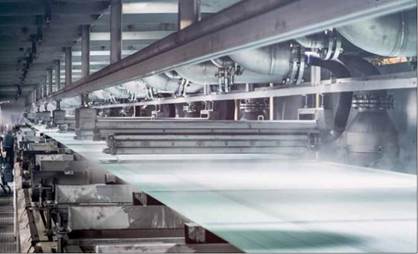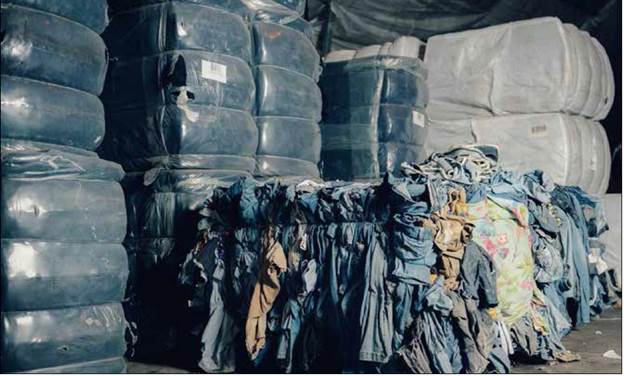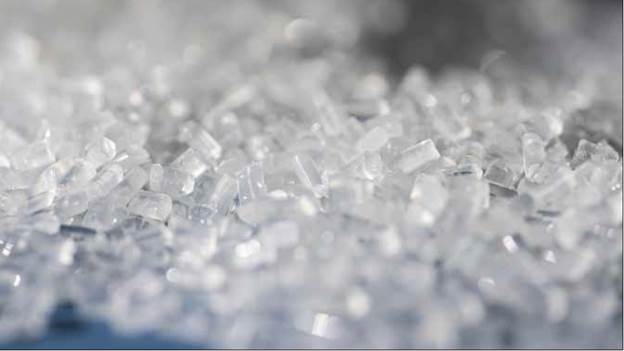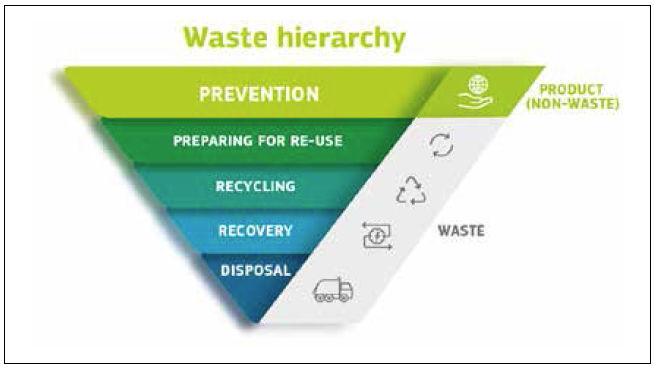The nonwovens-based absorbent hygiene industry is not alone in seeking new solutions from wood. It promises much for new textiles, packaging and alternatives to plastics too.
The European Union’s Single-Use Plastics Directive (SUPD) has acted as a spur for the further adoption of bio-based and recycled raw materials by the nonwovens industry, in particular cellulosic fibres based on wood.
The SUPD was announced back in 2019, largely as a reaction to the headline-generating issue of microplastics in the oceans, and singled out the ten products most commonly found discarded on European beaches. The list included femcare products – sanitary pads, panty liners, etc – as well as disposable wipes, both of which are primarily based on nonwovens. Baby diapers and adult incontinence (AI) products escaped the list, but there is no guarantee it will not be expanded to include them in the future.
In July 2021, EU laws have come into force requiring any of the ten listed products containing plastics or synthetic fibres to carry prominent warning labels, with extended producer responsibility (EPR) imposed for the cost of the collection of these products from the beaches and their disposal coming into place in December 2024. All of this suggests both significant additional costs for the brands behind absorbent hygiene products (AHPs), as well as unwanted damage to their consumer reputations.
Flushable Wipes
It is apparent that avoiding this new legislation has been less of a problem for manufacturers of disposable wipes than for femcare product makers. According to the current definitions of plastics, the key raw materials available to work with in order to avoid the SUPD labelling and EPR include wood pulp, viscose, starches, cotton, lyocell, cellulose derivatives, flax/hemp/sisal etc, and proteins. Bio-based and biodegradable plastics such as PLA (polylactic acid) and PHA (polyhydroxyalkanoate) are still currently defined as plastic, although debate is ongoing.

Wipes manufacturers were not responding to the SUPD from scratch, after the work that had gone into successfully developing flushable wipes based on these same alternative fibres. One of the major baby wipes grades in North America – Huggies Pure byKimberly-Clark, headquartered in Irving, Texas – has been 100 per cent plastic free for more than six years and all of the products conforming to the Flushability Guidelines, established by industry organisations EDANA and INDA, are now plastics-free.
In addition, a huge amount of work was done to better understand how toprocess staple
cellulosic fibres and speciality equipment has been designed tohandle and dose speciality wood pulp grades and cotton linters as synthetic fibre substitutes.
Carded/Pulp (CP) Technology
Tufropes, for example, is installing a new nonwovens manufacturing line from Truetzschler Nonwovens and Voith to target the growing Indian market for wipes. The line is based on patent pending ‘pentamerous technology’ which will allow the Gujarat, India-based company to produce five types of different eco-friendly wipe substrates and is based on Truetzschler/Voith core components for wet-laying, carding and hydroentangling. A similar line in Israel is in a sold-out situation. Truetzschler/Voith’s carded/pulp (CP) technology combines a cost-effective, wetlaid pulp layer and a carded web layer made from cellulosic fibres. Proprietary refinements will allow Tufropes to produce any possible hydroentangled nonwoven material, including biodegradable, natural fibre, eco-friendly high-performance nonwovens. As such, the technology is perfectly suited to producing wipes in full compliance with the SUPD.
Complex
Manufacturers of femcare products have faced challenges of a far higher magnitude in attempting to escape being impacted by the SUPD legislation. While not as complex as baby diapers, they are still multi-component products and largely based on extruded synthetic polymers. Their spunmelt nonwoven components cannot easily be replaced by natural staple fibres to any meaningful extent.
Waste Framework Directive
Further European Union legislation, this time in the shape of the Waste Framework Directive, is now having an equally galvanising impact on the textiles and apparel industry. This mandates that EU member states must set up separate collection for used textiles and garments by January 1, 2025, and that this waste can no longer be sent to landfill or incinerated. EPR is likely to be the financial instrument that ensures it happens.
At the 60th Dornbirn Global Fiber Conference (GFC), held virtually from September 15-17 this year, the implications of the Waste Framework Directive were explored in detail, with representatives from the nonwovens, textiles, paper, packaging and plastics industries all sharing insights, united by their reliance on either fibres or extruded resins as the basis of their products.
Packaging
EU rules on plastic packaging and packaging waste have, for example, beenin force
since 1994, but although their implementation has been considered a success, the amount of packaging waste in the EU is still increasing, and in 2018, the rules were revised and amended to include the mandatory setting up of EPR schemes for packaging waste.
Similar action against textile waste is hardly surprising – of the one hundred tons of textile fibres now produced every year, seventy million tons end up in landfill, with only a small fraction being recycled. And of the 80 billion garments produced each year, 30 per cent are sold at discounted prices and a further 30 per cent never sold at all.With as much as 90 per cent or more of a luxury garment’s value residing solely on its upmarket brand’s name – rather than the cost of its production – the system has long-been out-of-kilter and a large amount of stock not being sold has been the norm. At the opposite end of the spectrum, are the discount fast fashion brands squeezing every last fraction of a cent out of their suppliers, but at the same timestill over-producing.
The time has come for the industry to decouple its resource use from its resource growth, and as Uday Gill, chief strategy officer for Indorama Ventures remarked at the Dornbirn GFC: “Regulation works.”

Paper
The paper industry meanwhile achieves much higher recycling rates than the nonwovens, textiles or plastics industries, especially in Europe. The European Recovered Paper Council (ERPC) was established in 2000 as the industry’s own initiative and reports that the European paper recycling rate was 72 per cent in 2019. Fibre-based food packaging meanwhile has a recycling rate of 85 per cent in Europe. The demand for conventional paper, of course, has been shrinking ever since the advent of the internet, but there are many new and sustainable options for responsibly-sourced wood, and the paper industry has been actively developing them, not least in Scandinavia. Some of these options were outlined at the Dornbirn conference by Markus Mannström of the Biomaterials Division of Finland’s Stora Enso, one of the largest forest owners globally.
Climate Positive
Mannström pointed out that Stora Enso forests remove 1.5 million tons of CO2, while the company’s durable products for building solutions store a further 2.6 million tons and other products substituting for fossil-based alternatives save 17.9 million tons of CO2 each year. With the company’s value chain emissions amounting to 10.5 million tons, its overall footprint is –11.5 million tons, making its operations highly climate positive. “What we continue to explore is how to generate more products that store more carbon for a longer period of time and how to innovate new products to make more out of less,” Mannström said. With 23,000 employees globally, Stora Enso had sales of €8.6 billion in 2020, and first six-month sales of €4.9 billion. Its EBIT of €650 million in 2020 compared to €692 million for the first six-months of 2021 illustrates that the company has not been unaffected by the volatility of 2020. It has six divisions – Packaging Materials, Packaging Solutions, Biomaterials, Wood Products, Forest, and Paper, with the latter three viewed as its traditional businesses for cash generation and new growth to be achieved primarily in packaging and biomaterials.
R&D Network
A new Stora Enso innovation network focused on biomaterials has been established from scratch over the past six years, including two R&D centres, extensive laboratories and three pilot plants. The company already has a strong position in fibre-based packaging, with products such as Formed Fiber and Biofoam providing sustainable solutions. In biomaterials, meanwhile, lignin from forestry is being primed for use in applications such as anode materials for energy storage, bio binders and new carbon fibres. Stora Enso is anticipating a ten-fold growth in demand for anode materials due to the electrification of vehicles, and the Lignode plant it is currently ramping up in Sunila, Finland aims to see lignin-based products replacing graphite from coal mines. Lignin is also employed with a crosslinker for NeoLigno, a new biobinder with wide-ranging applications in insulation, flooring etc, as well as the basis for the carbon precursor material Stora Enso is developing in a JV with Cordenka, the German manufacturer of high-tenacity, cellulose-based man-made fibres.
Treetotextile
Earlier in 2021, Stora Enso also announced that TreeToTextile, its joint venture with H&M and IKEA, would invest €35 million to construct a demonstration plant in Sweden, in a critical step towards commercialising a sustainable new regenerated cellulose textile fibre based on a process for spinning dissolving pulp.
The novel process is designed to have low energy demand and low chemical needs and engineered to suit large scale production, including a recovery system for reusing chemicals. The plant is under construction at Stora Enso’s Nymölla mill in southern Sweden and will have an annual production capacity of 1,500 tons.
Circulose
TreeToTextile is just one of a range of new initiatives for regenerated fibres coming out of Scandinavia in response to the new demands of the EU’s Waste Framework Directive, and to a lesser extent, the SUPD for nonwovens. Renewcell, which is working with major brands including H&M, Inditex, Kering and Levi Strauss, plans to build a 60,000 ton capacity recycling plant in Sweden for the production of its Circulose fibre.

To make Circulose, discarded cotton textiles such as worn-out denim jeans are repurposed through a process akin to recycling paper, relying on a heavily-patented pulp production process. The incoming waste fabrics are broken down using water. The colour is then stripped from these materials, the slurry-like mixture is dried, and the excess water extracted, leaving behind a sheet of Circulose. This sheet isthen made into new viscose fibre.
At the Dornbirn GFC, the company’s chief growth officer Harald Cavalli-Björkmann said the four keys to achieving success with such new regenerated fibres were:
• Radical impact reduction
• Equal or superior quality
• Parity in pricing
• Massive scale
Cavalli-Björkmann also observed that there is currently no recycling process available for turning used textiles back into textiles.
Solutions Now
“Fashion needs solutions now,” he said. “The brands decide what gets made and put on the market and they are feeling the pressure, being consumer facing. They have posted ambitious sustainability goals and we are working in the supply chain to help them keep their promises.” He emphasised that the Circulose process relies on the legacy of the pulp and paper industry, drawing on its know-how, technology and trade craft in order to derisk and get to scale quicker. “We are leveraging the existing value chain and using its infrastructure,” he said. “The SCA site where we are building the new plant was dedicated to printed paper where there is no longer growing value, but we are establishing this new cellulose processing industry based on its know-how and its people. This kind of transformation is happening in other industries too, in automotive, aerospace and steel, and even McDonald’s has signed an agreement with Beyond Meat, looking to its future. It’s vital not to discard existing assets that can be exploited in new product supply chains.”
Infinna
Finland’s Infinited Fiber Company has also developed a process for turning cotton- rich waste textiles into high-quality, bio-based regenerated fibres, branded Infinna.
The process works with any cellulose-rich raw material including discarded textiles, but also used cardboard – which is increasing in volume as a result of the rise in internet shopping – rice or wheat straw, turning them into cellulose carbamate fibres with the look and feel of cotton.
“Infinna can be used with a variety of spinning technology and consumers can’t tell if the resulting fabrics are virgin or regenerated,” said Infinited CEO and founder Petri Alava. “It’s also a very versatile fibre.” Infinited has already announced collaborations with leading fashion and textile brands, including Besteller, H&M and Patagonia, as well as the Helsinkiheadquartered nonwovens manufacturer Suominen, and in April 2021 announced plans for a 30,000 metric tons per year plant in Finland, to be operational by 2024. “We are now licensing the technology with some of the world’s leading producers in order to speed up,” Alava said. “We’re also firming up quantities and prices for our output from the new plant in Finland.”
Spinnova
Taking a different approach to cellulosics is a second Finnish company, Spinnova, the developer of a fibre technology which CTO Juha Salmela stressed involves no dissolving chemistry. The development of Spinnova fibre originated from work to emulate the production of spider silk and spin filaments from cellulose. The company was spun off from the VTT and built its first pilot scale plant in 2019, becoming a public company listed on the Helsinki stock exchange last year. Spinnova technology enables fibre production from wood but also from textile waste or agricultural waste such as wheat straw. The process is said to use no harmful chemicals and 99 per cent less water than the cotton value chain. The fibre creates minimal CO2 emissions in production and is quickly biodegradable and contains no microplastics. “Our fibres are based on wood, but also waste textiles and leather and our process involves pulping before mechanical grinding, with no dissolving pulp needed,” Salmela explained. “Elementary fibrils are released in the process via patented spinning nozzles and the water is evaporated out. This is a dry spinning process with no washing cycles involved.”Spinnova has now partnered with Suzano, the world’s largest wood eucalyptus pulp producer to build Respin, a commercial scale fibre plant in Finland, with output to become available in 2022.
“The Respin production with Suzano will be based on pulp but we are also developing a second technology platform with KT Trading, owner of the Ecco shoe brand based on leather waste, called Woodspin,” Salmela said. “This production route could switch from leather waste to textile waste without having to be changed.”
Polypropylene
By far the most widely used synthetic fibre and resin for the nonwovens industry remains polypropylene (PP), especially for AHPs and medical disposables. Over the past few years, in response to the general pressure on plastics and synthetics, attempts to establish routes to the successful recycling and reuse of PP, as well as alternatives to the virgin fibre made from bio-based polymers, have understandably intensified. For a number of years now, cellulosics fibre leader Lenzing has been exploring the possibility of processing new types of biodegradable cellulose in exactly the same way that PP is turned into nonwovens for the majority of AHPs – i.e. by extruding them in a spunmelt system. INDEX20 exhibitor Lenzing (stand 2139) has invested €26 million in a pilot line for its Web Technology process, which started up in 2018 and has subsequently filed around 40 patents related to the new manufacturing route. At the Dornbirn conference, project manager Katharina Gregorich explained that in the process, dope cellulose is dissolved in MMO (n-methylmorpholine-n-oxide) and then extruded. The MMO is then washed out and recycled and the resulting web can then be hydroentangled. The resulting spun nonwovens are biodegradable in water and soil and also compostable in just a few weeks, as well as being finish and binder free. The Web Technology is also versatile, and Lenzing is manufacturing fine fibre (5-10 micron) webs and those based on coarser fibres of 20 microns and above. Multilayers are possible and the webs can be produced in basis weights of 16- 100gsm. As wipes substrates, these nonwovens offer good convertibility, fast wicking and homogenous lotion distribution in stacks.
Other target markets are cosmetic face masks—where the benchmark plastic carriers can be eliminated—and filtration, to produce media with high dimensional stability, low elongation and good pleatability. In AHP applications, 40gsm Web Technology webs are suitable for ADL (acquisition and distribution layers) where they provide good liquid spreading.
Purecycle
Cellulosics, however, won’t be replacing much polypropylene in AHPs anytime soon, and such is the demand for recycled polypropylene, that the annual 50,000 tons which will be recycled by PureCycle Technologies (PCT) at its plant in Ironton, Ohio, is sold out for the next twenty years – and production will not start there until the fourth quarter of 2022.
PCT’s technology is based on a global license for a patented solvent-based purification recycling technology developed by Procter & Gamble. It allows a wide range of waste PP with varying levels of contamination to be processed, effectively removing contaminants, including colour and odour, to create an ultra-pure PP resin. While PCT operates independently from Procter & Gamble, the new company is likely to play a major role in helping the corporation meet ambitious sustainability goals. With sales of $71 billion in its financial year to June 2021, P&G is a huge user of polypropylene, in nonwovens but also in injection moulded components and plastic films. It intends to make all of its packaging recyclable or reusable, and to replace 50 per cent of all of the virgin plastics it uses with recyclable or reusable alternatives, by 2030.
Value
“How we achieve this 50 per cent reduction will be via a number of routes, either by employing recycled or biobased materials,” said John Layman, Procter & Gamble’s head of corporate R&D and the founding inventor of PCT. “Overall, plastics have too much value to be thrown away, but the price of a single plastic component is so low it’s difficult to recapture any of that value. Plastics are both a success and a tragedy, being so pervasive and useful in our lives, but not in the environment.“There is a lot of lip service currently being given to circularity but there is not as much true recycling going on as consumers think. A single recycling step of turning waste plastic into park benches which then go to landfill is not enough – achieving quality that is just like virgin PP with the same regulatory approvals, and restoring it to products with no trade-offs in an endless cycle, is PCT’s goal.”
The three main challenges, he added, are removing contamination, colour, and malodour.“The plastics waste stream consists of a huge diversity of different plastics in different forms, so pulling a single polymer out of it profitably is extremely tricky,”he said. “A key advantage of our process is its simplicity. With far fewer steps than pyrolysis, it consumes a lot less energy and ultimately is much more cost effective.”
One BillIon Pounds
In July this year, PCT announced the location for a further cluster facility in Augusta, Georgia, with an initial $440 million investment to fund three lines which will add 65,000 tons of capacity during Phase 1 of the project. In August, PCT then signed an understanding with SK Global Chemical as a first step to establishing a PP recycling facility in South Korea.“Partnering with the leading recycling waste company in South Korea is a major milestone,” said PCT CEO Mike Otworth. “We are bringing together a premier team of experts to achieve our goal of recycling one billion pounds of PP waste by 2025.”
Drop-In Solution
Another important milestone was reached at the beginning of December 2020 by INDEX 2020 exhibitor Fibertex Personal Care (stand 1430) which introduced the first nonwovens created from post-consumer mixed plastics that have been broken down into their molecular building blocks and then re-polymerised to create virgin plastics. These nonwovens were developed in a cooperation with first-time exhibitor at this INDEX 2020, SABIC (stand 4673), which is now emerging as a strong collaboration partner to nonwovens manufacturers with its Purecares dedicated portfolio of PP for AHPs. Launched at the beginning of 2020, Purecares consists of dedicated ranges of polymers for nonwovens, films and laminates – including those based on SABIC Trucircle circular PP, using feedstock derived from previously used plastics. The new circular PP can be used as a drop-in solution while meeting all requirements for purity and consumer safety.
Bio-Pp
Two of the major European PP manufacturers – LyondellBasell, one of the world’s largest plastics, chemicals and refining companies globally, and Borealis – have meanwhile announced progress with a technology for producing bio-PP from agricultural waste. Both projects are joint ventures with Neste, based in Espoo, Finland. Neste produces bio-based alternatives to conventional fossil-based feedstocks for the production of polymers and chemicals and with its proprietary technology claims it can utilise nearly any bio-based oil or fat as a raw material, including lower-quality waste and residue oils, to produce various premium-quality renewable products.

Lyondellbasell
Based on Neste’s technology, in June 2019 LyondellBasell, headquartered in Rotterdam, the Netherlands, announced the first parallel production of bio-based PP and bio-based low-density polyethylene (LDPE) at a commercial scale. This project used Neste’s renewable hydrocarbons. LyondellBasell has subsequently introduced a new Neste RE renewable feedstock to its site in Wesseling, Germany, which was converted directly into the bio-based PE and PP. An independent third party tested the polymer products using carbon tracers and confirmed they contained over 30 per cent renewable content. In April 2021, LyondellBasell launched the Circulen family of products. LyondellBasell’s CirculenRenew range consists of polymers linked to renewablebased feedstocks, while polymers made from mechanically recycled materials are marketed under the brand name CirculenRecover and those linked to advanced molecular recycling are called CirculenRevive. In June 2021, LyondellBasell announced a long-term commercial agreement with Neste to source the Neste RE feedstock.

Borealis
Vienna, Austria-headquartered Borealis also announced a strategic co-operation for the production of renewable PP with Neste in October 2019. It enabled Borealis to start using Neste’s 100 per cent renewable propane as a feedstock at its facilities in Kallo and Beringen in Belgium. Borealis has used Neste’s renewable propane, produced in Rotterdam, to create an entire portfolio of applications based on renewable-PP called Bornewables, commercially launched in March 2020. The manufacturing process has subsequently been independently certified to ISCC (International Sustainability and Carbon Certification), guaranteeing that the renewable feedstock is certified renewable, sustainably produced and traceable to the point of origin. In April this year, INDEX 2020 exhibitor Berry Global (stand 2631) announced an agreement with Borealis for access to its circular PP. “Investments in chemical recycling with partners like Borealis are critical as we collaborate across the value chain to solve the global commitment to achieving net-zero emissions by 2050,” said Jean-Marc Galvez, president of Berry’s Consumer Packaging division. “Plastics are a critical solution as we advance towards circularity.”
About the Author: Adrian Wilson is a freelance analyst, writer, editor and public relations specialist in the technical textiles, nonwovens, composites and advanced technologies industries.
This article was first published in the October 2021 edition of the print magazine.








Comments